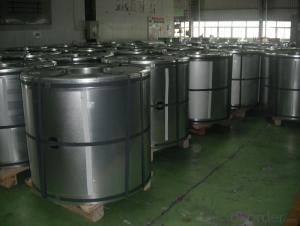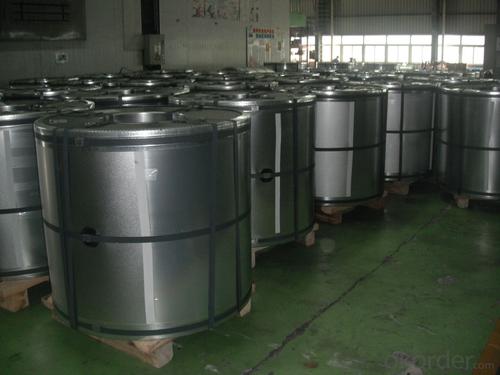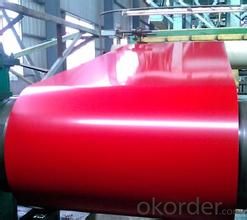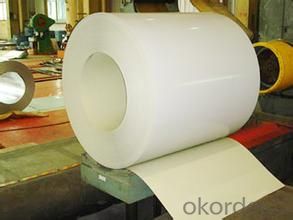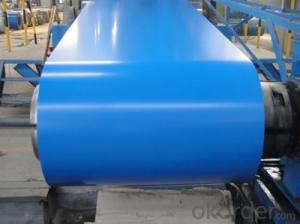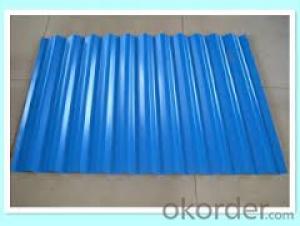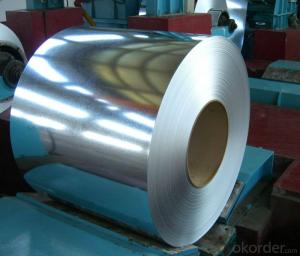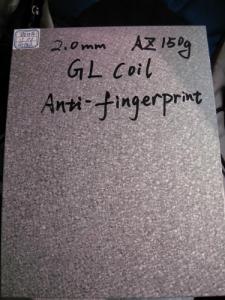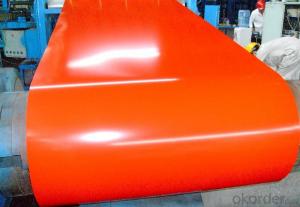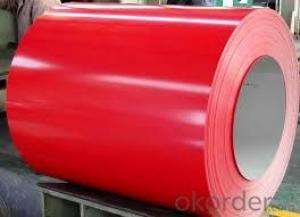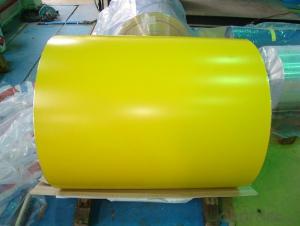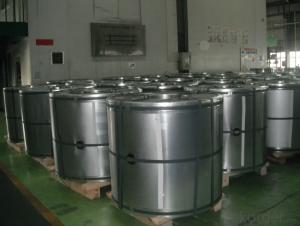Prepainted Hot Dipped Galvalume Steel Sheet In Coils
- Loading Port:
- Qingdao
- Payment Terms:
- TT OR LC
- Min Order Qty:
- 100 m.t.
- Supply Capability:
- 20000 m.t./month
OKorder Service Pledge
OKorder Financial Service
You Might Also Like
Prepainted Hot Dipped Galvalume Steel Sheet in Coils
1.Structure of Prepainted Hot Dipped Galvalume Steel Sheet in Coils
Prepainted Hot Dipped Galvalume Steel Sheet in Coils is one kinds of building material on construction.Steel sheet in melting zinc trough, the sticking of a layer of zinc sheet. At present mainly adopts continuous galvanizing process, namely the continuous roll of steel plate in the melt zinc plating tank made of galvanized steel sheet; Alloying of galvanized steel. This kind of steel plate is made by hot dip method, but after the slot, immediately heated to a temperature of about 500 ℃, it make the generation of zinc and iron alloy membrane. This kind of galvanized volumes with good coating of the sex and weldability.
Color coated steel coil(ppgi) is made by the processes of chemical preconditioning, first coating, precision coating and so on through a continuous rapid unit internationally in recent three decades. Its quality is more uniform and stable than the one whose surface of the formed metal is coated single or brushed one.
2.Main Features of Prepainted Hot Dipped Galvalume Steel Sheet in Coils.
1) Rust-proof
2) Water-proof
3)Durable using
3. Prepainted Hot Dipped Galvalume Steel Sheet in Coils Images
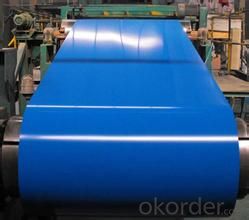
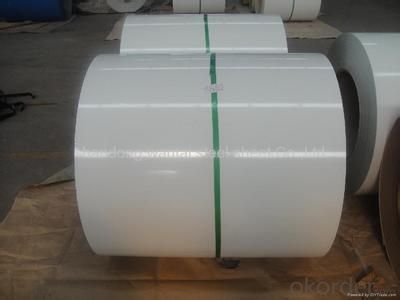
4. Prepainted Hot Dipped Galvalume Steel Sheet in Coils Specification
1)Based raw material: Hot rolled steel coils or Cold rolled steel coils
2) Thickness
3) Width
4)Coating mass
5) Spangle
6)Surface treatment
7)Coil inner diameter
8)Painting kind
9)Painting color
10)Painting thickness
5.FAQ of Prepainted Hot Dipped Galvalume Steel Sheet in Coils
We have organized several common questions for our clients,may help you sincerely:
①How about your company?
A world class manufacturer & supplier of castings forging in carbon steel and alloy steel,is one of the large-scale professional investment casting production bases in China,consisting of both casting foundry forging and machining factory. Annually more than 8000 tons Precision casting and forging parts are exported to markets in Europe,America and Japan. OEM casting and forging service available according to customer’s requirements.
②How to guarantee the quality of the products?
We have established the international advanced quality management system,every link from raw material to final product we have strict quality test;We resolutely put an end to unqualified products flowing into the market. At the same time, we will provide necessary follow-up service assurance.
③How to contact with you?
You can go to our website to find what you need and send the inquiry on line, or you can contact with the manager you know in our company dirrectly.
- Q: How are steel coils used in the production of metal partitions?
- The production of metal partitions relies heavily on steel coils, which are a vital ingredient. These coils, typically made from top-notch steel, act as the primary material for manufacturing the partitions. To begin with, the steel coils undergo a process called slitting, where they are sliced into narrower strips of the desired width. This step allows manufacturers to tailor the size of the metal partitions according to specific project requirements. Following slitting, the steel strips are fed into a roll forming machine. This machine gradually transforms the strips into the desired profile for the metal partitions. The roll forming process involves passing the steel strips through a series of rollers, which progressively bend and shape the metal into the desired form and dimensions. Once the metal has been shaped as desired, it is then cut into appropriate lengths to create individual partitions. These partitions undergo further processing, such as welding or spot welding, to join different components and enhance their structural integrity. Steel coils are highly preferred for metal partition production due to their strength, durability, and versatility. The use of steel ensures that the partitions can withstand heavy loads, resist corrosion, and offer long-lasting performance. Moreover, steel coils provide a high degree of design flexibility, allowing for the creation of various partition styles, including solid panels, perforated screens, or mesh partitions. All in all, steel coils play a pivotal role in the production of metal partitions by providing the necessary raw material, strength, and customization options required for these adaptable architectural elements.
- Q: I have heartgold and I don't have a steel type Pokemon to beat lapras. HELP
- magneton. steel and electric type
- Q: ive made lots of knives but they are dark and not shiny. how do i polish a knife and make it shiny
- Look for buffing compound at the hardware store. Home depot lowe's od even Wal-mart/ There is a compound for steel and for iron. I t will not make iron real shinny but it will make it look good. This stuff is to be used with a buffing wheel but I have used it on rags and it work great.
- Q: What are the different types of coil recoiling machines?
- The different types of coil recoiling machines include manual coil recoilers, semi-automatic coil recoilers, and fully automatic coil recoilers.
- Q: Where can a find a steel scrubber. Its great to clean cooking vessels. Would be great if someone gives me an idea. I did not find it at CVS, but was in a hurry, will try again tomorrow.
- I posted this earlier to a similar question... Really burnt on gunk in the bottom like milk or blackened food can easily be cleaned out of stainless steel pots and pans by sprinkling baking soda in the bottom, covering with vinegar, let simmer with a little water for 5 min. Let cool, scrub out with a vinyl scrubby. or I use a lot of stainless steel for cooking and over the years have found a very inexpensive solution to cleaning them especially the ones with burnt food stuck at the bottom. I use Used fabric softner sheets (sheets that i have already used in the dryer for my clothes) and have them soak in water in the dirty pan overnight. Next morning i use the same sheet as scrubber to clean the pan and all the burnt food comes off easily leaving a new look to the pan. Try it this works.
- Q: what is the difference between metal and steel
- well, steel is a type of metal. It's sort of like asking the difference between a bug and an ant, an ant is a bug, but not every bug is an ant. Likewise, steel is metal, but not all metal is steel. Gold is metal, Silver is metal, Iron is metal, Steel is metal.
- Q: How are steel coils used in the appliance industry?
- Steel coils are commonly used in the appliance industry for various purposes such as manufacturing washing machines, refrigerators, dishwashers, and other household appliances. These coils are typically used to form the structure of the appliances, provide strength and durability, and support the weight of various components. The steel coils are also used in the production of heating elements, motors, and other key components that ensure the efficient operation of appliances.
- Q: Well actually I was just wondering why people were bashing on stainless so much for katanas. I heard that they don't hold their edge as well as carbon steel blades or Damascus steel. So what makes it so inferior to carbon or other types of steels?
- No real swords are made of stainless steel. Its is simply a poor material for swords. Only kitchen knives that are required to be easy to clean and corrosion resistant are made of stainless. Adding chromium and other trace elements adds nothing to the ability to cut well or hold an edge. It is not strong enough to withstand the forces involved, being too brittle and lacking in toughness. Those decorative swords are not really swords at all.... rather they are sword shaped objects.
- Q: How are steel coils inspected for yield strength?
- Steel coils are inspected for yield strength through a series of testing methods. The most common and widely used method is the tensile test. In this test, a small sample is taken from the steel coil and subjected to a controlled load until it reaches its yield point. During the tensile test, the sample is gradually stretched until it deforms and ultimately breaks. The load and elongation data are continuously recorded during this process. The yield strength is then determined by identifying the point on the stress-strain curve where the material begins to exhibit plastic deformation or permanent elongation. Another method used to inspect steel coils for yield strength is the hardness test. Hardness is often correlated with yield strength, and therefore, a hardness test can provide an estimation of the material's yield strength. This test involves measuring the resistance of the steel coil's surface to indentation or penetration using instruments like a Rockwell or Brinell hardness tester. Additionally, non-destructive testing methods such as ultrasonic testing and magnetic particle inspection can also be employed to evaluate yield strength. Ultrasonic testing involves the use of high-frequency sound waves to detect any internal defects or inconsistencies in the material's structure. Magnetic particle inspection, on the other hand, relies on the application of magnetic fields and the use of magnetic particles to identify surface cracks or defects. Overall, various testing methods are available to inspect steel coils for yield strength. These methods provide manufacturers and inspectors with valuable information about the quality and performance capabilities of the steel, ensuring that it meets the required standards and specifications.
- Q: What are the different types of steel coil surface finish treatments?
- There are numerous options for treating the surface finish of steel coils, each serving a distinct purpose and offering unique qualities. Several common types include: 1. Hot Rolling: This is a fundamental and widely-used treatment method for steel coil surface finish. It involves heating the steel above its recrystallization temperature and then rolling it to achieve the desired thickness. This process yields a rough surface texture. 2. Cold Rolling: In contrast to hot rolling, cold rolling involves rolling the steel coil at room temperature. This treatment produces a smoother surface finish with improved dimensional accuracy and tighter tolerances. 3. Galvanization: Galvanization is a process in which a protective zinc coating is applied to the surface of the steel coil. This treatment not only enhances the appearance, but also provides excellent corrosion resistance, making it suitable for outdoor applications. 4. Electro-Galvanization: Similar to galvanized steel, electro-galvanized steel coil is coated with a layer of zinc. However, this coating is applied through an electroplating process, resulting in a thinner and more controlled coating. 5. Pre-Painting: Pre-painting involves applying a layer of paint or protective coating to the steel coil before it is delivered to the customer. This treatment enhances the appearance and provides additional protection against corrosion. 6. Stainless Steel: The surface finish treatment for stainless steel coils involves passivating the steel to remove any impurities or contaminants on the surface. This process improves corrosion resistance and gives the steel a clean and smooth appearance. 7. Embossing: Embossing is a treatment where a pattern or design is pressed into the surface of the steel coil. This treatment enhances the aesthetic appeal and can provide added grip or texture, depending on the specific design. 8. Brushing: Brushing is a treatment that involves using a fine abrasive material to create a brushed pattern on the surface of the steel coil. This finish provides a unique texture and can help conceal scratches or imperfections. These are just a few examples of the different surface finish treatments available for steel coils. The choice of treatment depends on the specific requirements of the application, such as appearance, corrosion resistance, or functionality. It is crucial to select the most suitable treatment to ensure the desired outcome.
Send your message to us
Prepainted Hot Dipped Galvalume Steel Sheet In Coils
- Loading Port:
- Qingdao
- Payment Terms:
- TT OR LC
- Min Order Qty:
- 100 m.t.
- Supply Capability:
- 20000 m.t./month
OKorder Service Pledge
OKorder Financial Service
Similar products
Hot products
Hot Searches
Related keywords
